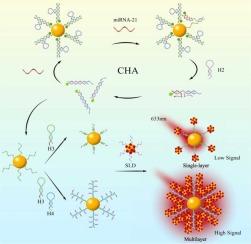Dual-mode biosensor based on cascade CHA-HCR amplification and multilayer core-satellite nanostructures for highly sensitive microRNA detection
IF 3.7
1区 化学
Q1 CHEMISTRY, ANALYTICAL
引用次数: 0
Abstract
To achieve highly sensitive and reliable detection of pivotal cancer diagnostic biomarkers like miRNA, and to develop a novel core-satellite assembly strategy for SERS sensing platforms with high "hot spot" density, this study introduces an innovative approach. We integrate enzyme-free, isothermal Catalytic Hairpin Assembly (CHA) and Hybridization Chain Reaction (HCR) in a cascaded manner to construct multi-layered "core-satellite" nanostructures. CHA enables specific target recognition and initial signal amplification, while subsequent cascaded HCR generates long dsDNA scaffolds, facilitating the assembly of multiple satellite nanoparticle layers around a central core. This design significantly increases the number and density of SERS "hot spots," leading to substantially enhanced signals. The strategy was successfully applied for the highly sensitive detection of miRNA-21. Furthermore, a dual-modal biosensing platform combining fluorescence and SERS outputs was developed, improving detection reliability and accuracy. This work presents a robust methodology for precise miRNA analysis and advances the development of high-performance, multi-layered core-satellite nanostructures for broader biosensing applications.

基于级联CHA-HCR扩增和多层核心-卫星纳米结构的高灵敏度微rna检测双模生物传感器
为实现miRNA等关键癌症诊断生物标志物的高灵敏度、高可靠性检测,为高“热点”密度SERS传感平台开发新型核心-卫星组装策略,本研究引入了一种创新方法。我们将无酶、等温催化发夹组装(CHA)和杂交链反应(HCR)以级联的方式结合在一起,构建了多层“核心-卫星”纳米结构。CHA可以实现特定的目标识别和初始信号放大,而随后级联的HCR产生长dsDNA支架,促进围绕中心核心的多个卫星纳米颗粒层的组装。这种设计显著增加了SERS“热点”的数量和密度,从而大大增强了信号。该策略成功应用于miRNA-21的高灵敏度检测。此外,开发了结合荧光和SERS输出的双模态生物传感平台,提高了检测的可靠性和准确性。这项工作为精确的miRNA分析提供了一种强大的方法,并推动了高性能、多层核心-卫星纳米结构的发展,用于更广泛的生物传感应用。
本文章由计算机程序翻译,如有差异,请以英文原文为准。
求助全文
约1分钟内获得全文
求助全文
来源期刊

Sensors and Actuators B: Chemical
工程技术-电化学
CiteScore
14.60
自引率
11.90%
发文量
1776
审稿时长
3.2 months
期刊介绍:
Sensors & Actuators, B: Chemical is an international journal focused on the research and development of chemical transducers. It covers chemical sensors and biosensors, chemical actuators, and analytical microsystems. The journal is interdisciplinary, aiming to publish original works showcasing substantial advancements beyond the current state of the art in these fields, with practical applicability to solving meaningful analytical problems. Review articles are accepted by invitation from an Editor of the journal.
 求助内容:
求助内容: 应助结果提醒方式:
应助结果提醒方式:


